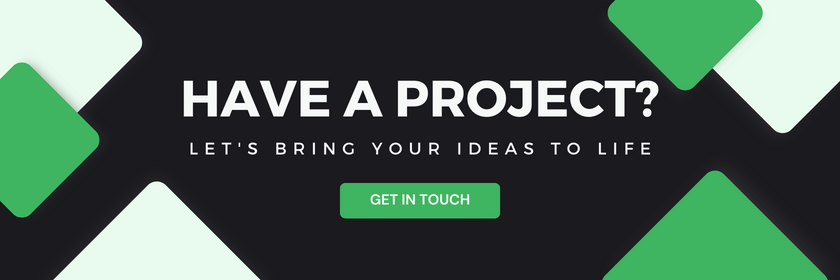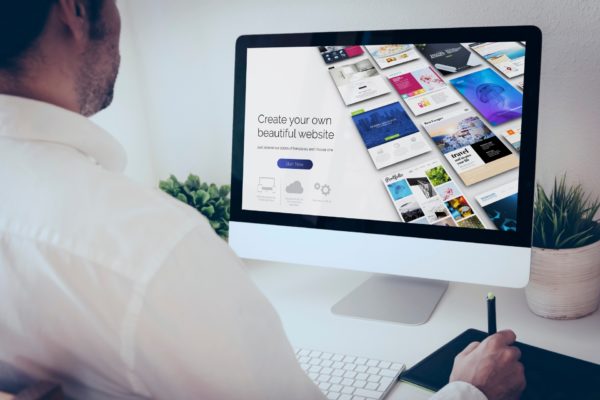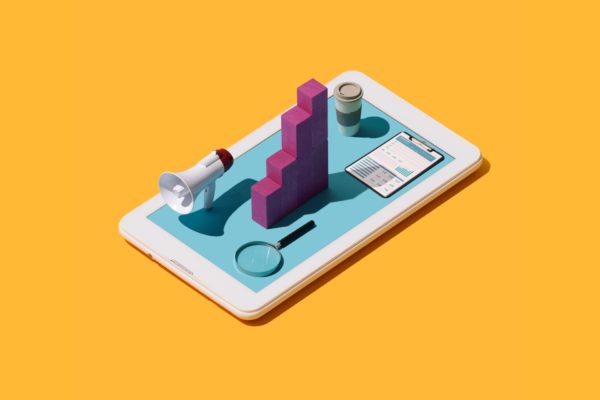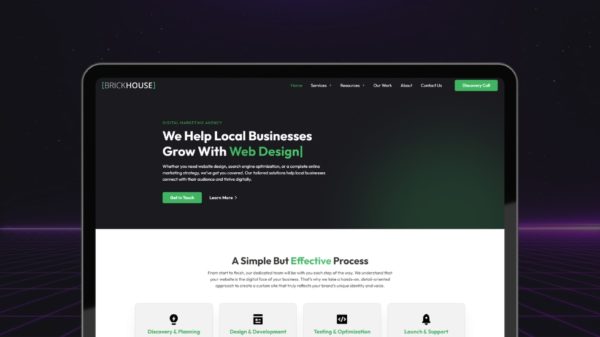By Tyler Besse
Recently I completed the SEMrush Certification for Local SEO. This certification included an online course presented by Greg Gifford followed by a timed exam. The purpose of the course was to learn about the tools and best practices of Local SEO and how we can help businesses reach the top of local search results.
The courses included a 10 part lesson focused on:
- What is Local SEO
- Local Ranking Factors
- Building Local Links
- Developing Localized Content
- Boosting Local Citations
- Leveraging Satisfied Customers into Reviews
- Optimizing Google My Business
- Utilizing Google Posts and Q&A
- Other Signals
- Website Local SEO Reporting & Analytics
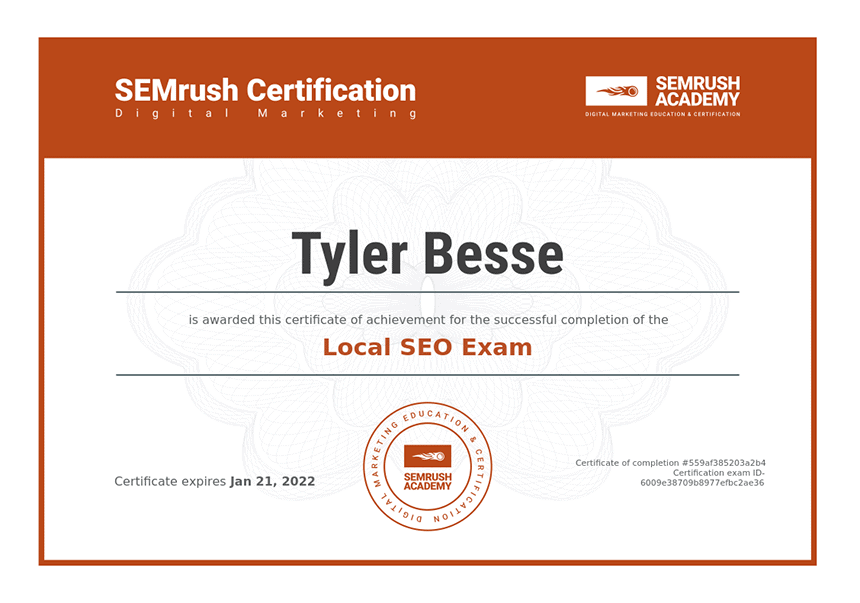

Lesson 1: What is Local SEO?
SEO stands for Search Engine Optimization. It is the practice and method to help boost your rankings on Google and other popular search engines. A well-versed SEO team will provide a variety of services in order to help with your website’s SEO. Local SEO is similar to SEO in that it is the process and method of increasing the organic search traffic onto your website. Local SEO varies from this in that the focus is to increase the local visibility of your brand.
In this introduction to the course, Greg Gifford focused on what local SEO is and discussed which types of business this type of service are important for. An example he recommended to check to see if Local SEO is right for your business is to search the keyword for your business. If the map pack shows up in the search results then Local SEO may be right for you.
Lesson 2: Local Ranking Factors
Ranking factors are the components that search engines like Google, Bing, etc. use to decide the order in the search results for key terms and phrases.
In this part of the lesson, Greg Gifford provided us with a breakdown of the main “signal” factors that influence your companies local Google rankings. A signal factor can come in a variety of ways with some including the number of local backlinks, providing your users with local-focused content, having a variety of local positive reviews from satisfied customers, etc.. More on these items in the coming sections.


Lesson 3: Building Local Links
Backlinks are an essential component in search engine ranking factors. Backlinks are when another website links to your website. Google and other search engines put weight on this factor since it is essentially another business or website referring to your website as a valuable company/business.
Links and backlinks don’t work the same way for SEO as it does for Local SEO. A few interesting differences are as follows.
- Local SEO doesn’t care as much about no-follow and follow links. For SEO in general a no-follow link to your website isn’t going to help your search results in Google. But for Local SEO a local no-follow link vs a local follow link is not going to have a significant difference for your local rankings.
- The authority score of the local link provider isn’t as important as the authority score not non-local SEO. This important distinction is done so that if a local company talks about your business on their website and links to it, regardless of how big time their website is shouldn’t matter and it should be a local link and reference for your business. This means that if you support a local sports team, even if their website has an incredibly low authority score, it should be helpful to improving your local search results.
An authority scores essentially how search engines rank your website. A higher authority score, a better position on key search terms relating to your website.
Lesson 4: Developing Localized Content
Content is an important part of any website in getting found organically through search engines. The more engaging and relevant content, the higher the likelihood that your website will get found.
In this lesson, Greg talks about how to write local content that is optimized for local SEO. He talked about how it is really tempting with local SEO to say the location and product as many times as you can throughout the website, but this becomes very obvious for consumers and makes people shy away from your content. It used to be that you could just say the keyword and location 100 times on a page and be ranked number 1 instantly, but Google has gotten much smarter and may penalize you for providing unreadable or cumbersome content to your users. One recommendation they had was to always read your content out loud. If you find it is tough to get through or clearly is spamming keywords then your potential customers are going to notice the same issue.
Another item that Greg talked about was not to shy away from writing blogs and content about local things happening in your area. Even if it is unrelated to your business. Talking about local happenings will help you get found more often when people are searching for a local business.
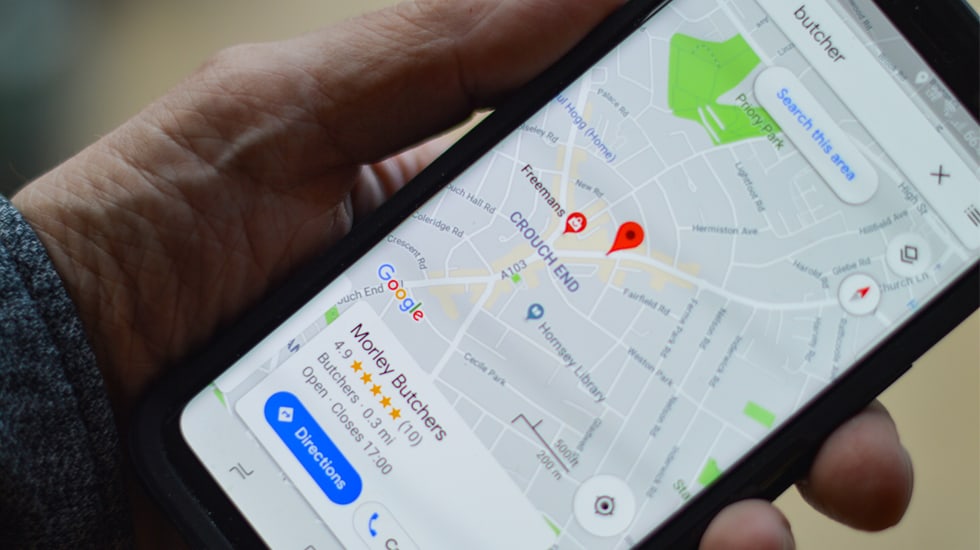

Lesson 5: Boosting Local Citations
In this lesson, Greg talked about how to deal with mentions of your business’ NAP on other sites and how they influence local search visibility. NAP stands for Name, Address, and Phone. It is crucial that any website that cites your business has the correct NAP. They mention tools that can help crawl all backlinks and ensure that the correct NAP is shown. Having incorrect NAP information on other websites can really hurt your business’ credibility in both the eyes of search engines and the eyes of potential customers.
Lesson 6: Leveraging Satisfied Customers into Reviews
This part of the course talked about online reviews for your business. It is described that not only Google reviews get factored into your rankings but reviews from other websites (Facebook, Yelp, etc.) play a large factor in determining your rankings as well. They recommend making a page on your website with an easy-to-find URL (i.e., yourwebsite.com/review) that has direct links to all of your review platforms. This makes it really easy for customers to review your business.
Any review that comes in warrants a personalized response from the business. Both positive and negative reviews should be responded to. For negative reviews, it is really important that you respond honestly but without emotion. You aren’t just responding to that client; you are responding to any future client that sees that negative review as well. You don’t have to have a perfect score for people to trust your business. They actually referenced a study that showed that people trust companies that have a review between 4.2 and 4.5 stars more than a company with a perfect 5-star ranking.
Lesson 7: Optimizing Google My Business
Google My Business is described as the “new homepage” of your business. The reason for this is that this is where your customers will get the first impression of your company before they even go to your website. This topic described the importance of optimizing your Google My Business (GMB) and making sure that all of the information is up-to-date and accurate. The course recommended using high-resolution photos for the photos section and updating them with new photos every so often. Keeping the content fresh and new is important for customers.


Lesson 8: Utilizing Google Posts and Q&A
This topic within the course talked about an underutilized aspect of Google My Business. That aspect being Google Posts and the Question-and-Answer section of the platform. The Google Posts can be an opportunity to display a picture of a product, or service provided for a customer. The Q&A section is a good platform to display questions and answers to some of your most frequently asked questions. A lot of your competitors aren’t using this part of the tool so it is a great way for you to stand out from the competition.
Lesson 9: Other Signals that determine your local search rankings
Lessons 1-8 really highlighted the most important key elements that go into local search engine optimization. This section talked about some of the other factors that can play into it. For example, Greg talked about Yelp and other business directory sites that can be utilized to help provide another platform for information regarding your business as well as provide another platform for client reviews.


Lesson 10: Website Local SEO Reporting & Analytics
All of these efforts are a great way to boost your Google rankings locally! However, wouldn’t it be great to be able to track our efforts! Well, this part of the course focused on the use of the tool Google Data Studio. Within Google Data Studio you have the option to import data from a variety of different sources. We personally love to pair the Google Analytics data with the data provided by SEMrush. SEMrush does a great job of providing data related to how you are ranking for some of your business’s most important search terms.
Conclusion
Now for the corny part. One of the main reasons I go through these types of certification programs is to help boost my own knowledge on these topics. I consider myself a lifelong learner and love any opportunity I can take to either learn something new or strength my knowledge on topics. Though the Berkshires are a small town I want to be a part of growing businesses in Pittsfield MA and beyond. We believe with tools like local SEO and our website design skills we can really provide a great service to our community.



